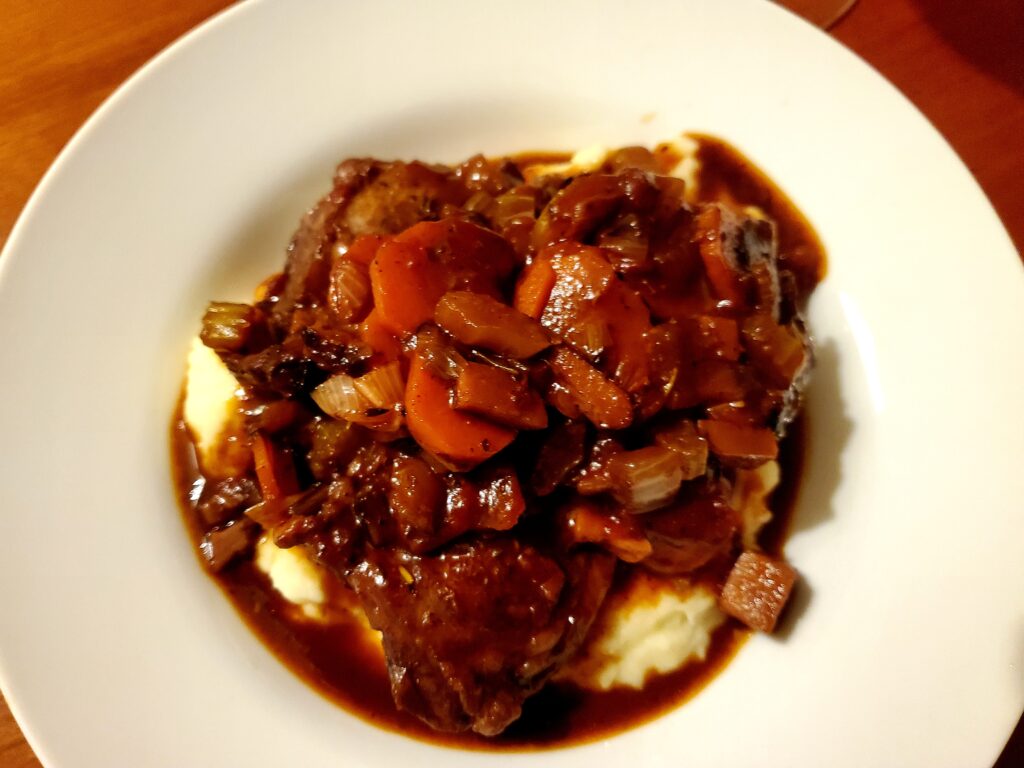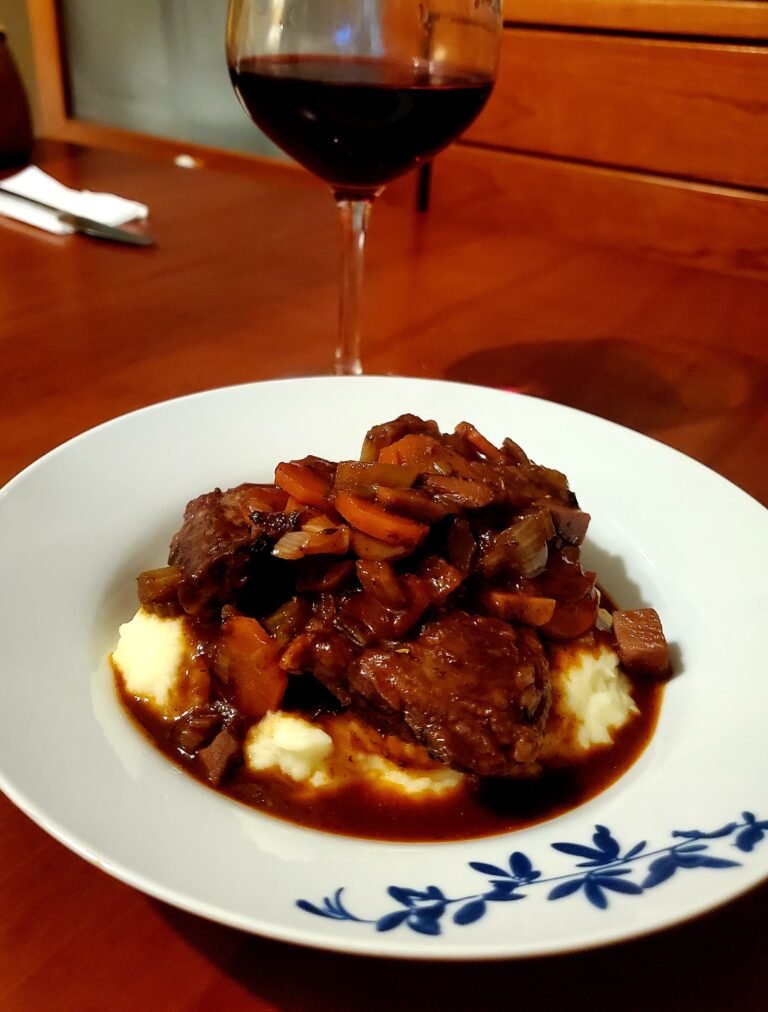
Pork Cheeks braised in Red Wine Sauce over Mashed Potatoes
(Carrilleras de Cerdo a la brasa en Salsa de Vino Tinto sobre Puré de Patatas)
Ingredients & Instructions (recipe for two)
Mashed Potatoes
3 to 4 medium yellow potatoes peeled, quartered, and chopped
Water – enough to cover the potatoes in your pot
Salt – a pinch
Butter – a large pat to your liking
Cream – 2 dollops
Boil potatoes in water on high heat until semi-soft and drain. Turn off heat, put potatoes back into pot, add salt, butter, cream, and blend together with a masher or wooden spoon, cover and set aside to keep warm.
Pork Cheeks in Wine Sauce
6 to 10 Pork Cheeks size depending, these should be cut into medallions 2”x2” or 3”x3” roughly. Pork cheeks are a wonderfully tender cut of red or dark pork meat that is sinewy, but with a lovely amount of striated fat and collagen that melts beautifully into a sauce. The flavor is more delicate, but reminiscent of wild boar than any other cut of pork in my opinion. You could use boneless pork shoulder steaks cut to size or even a tenderloin with added butter if pork cheeks are not available at your market. (Whenever I cook meat, I salt and pepper it and set it out of the refrigerator to get to room temperature before cooking. This gives it added time to tenderize).
Mirepoix (or the holy trinity of veg) – 1 carrot, 1 medium onion, and 1 stalk of celery, all chopped and diced, or you can leave the carrot cut in rounds as I did (cook’s prerogative).
Extra Veg – 2 to 3 mushrooms stemmed and chopped, 1 small leek chopped (this is optional, but since I had it, I threw it in) a turnip, some radishes, or peas, or anything else you like to add for extra flavor and texture in my book is always good.
1 to 2 Cloves of Garlic sliced and diced
1 small can/jar of Tomato Sauce roughly a quarter cup or more
1 cup of Red Wine – as Julia Child used to say, “if you can’t drink it, you shouldn’t cook with it”. I generally cook with the wine I am serving with the meal, which is always a complementary idea. Pour yourself some too! A little for me, a little for the sauce. Like I said with the broth, a splash or 2 extra to keep the sauce wet may be necessary. I will make for a more tender meat on your plate.
A half cup of Water or Broth (veg, chicken, or beef) I like hearty sauces, so broth is my go-to for added moisture. You may need a little more than a ½ cup to keep your sauce wet to braise the pork, so practice intuitive cooking and keep your eye on the pot in case you need more. (For cooking liquids, I always set them out to get to room temperature before adding them to a pot so as not to shock the sauce. This also reduces your cooking time as you are not adding time to get liquids up to the cooking temperature once again.)
A few dashes of Herbs de Provence – rosemary, marjoram, basil, oregano, thyme, and savory if your herbs are separated. Lavender, fennel, tarragon, and parsley are also nice additions and are often found as extra ingredients in some Herbs de Provence spice blends.
A drizzle of Oil Olive and a pat of Butter for sautéing the pork and veg
Salt and Pepper to taste
Start by adding the olive oil and butter into a braising pan at a medium-high heat (not too high as you don’t want the oil to smoke). Add the salt and peppered pork cheeks to brown for a few minutes on each side. Once browned remove meat from pan and set aside in a bowl to rest.
Next add a little more oil if needed to the pan and add all of your vegetables, except for the garlic and tomato sauce. Sauté these mixing occasionally with a wooden spoon until the onion becomes translucent. Then add the garlic for a turn or two in the pan with the spoon for a minute and then add the tomato sauce and do the same.
Next add the red wine and let that bubble off some of the alcohol and pan scrapping for another minute or two. Add the water and the broth and stir. Then place the meat into the sauce. At the bottom of the bowl the meat will have released some liquid while resting, add this to your pot too. You will want the extra flavor in your sauce. Shake the pot a little for the meat to settle in. Turn the heat down to a simmer and cover.
Time is your friend here, the longer your patience is to let the meat cook in the braising sauce the more your flavors have a chance to blend and your meat to become more succulent. The pork cheek medallions are generally thin, so this dish will be ready to serve in 15 to 20 minutes, but a hour to simmer will not hurt this dish as long as you keep an eye on the sauce to make sure it does not dry out. If the liquid reduces just add more wine and/or broth and give it a chance to simmer before serving.
The cooking of the meat and the potatoes is a simultaneous process, but inevitably the potatoes will be done first. When the sauce ready, dish up the potatoes and ladle sauce over them, place several medallions of pork on top and ladle another portion of sauce over that and serve. This is a relatively simple meal or entrée to make, and the deep flavor will be a warming reward to your tastebuds. Enjoy!



